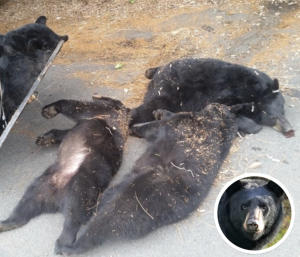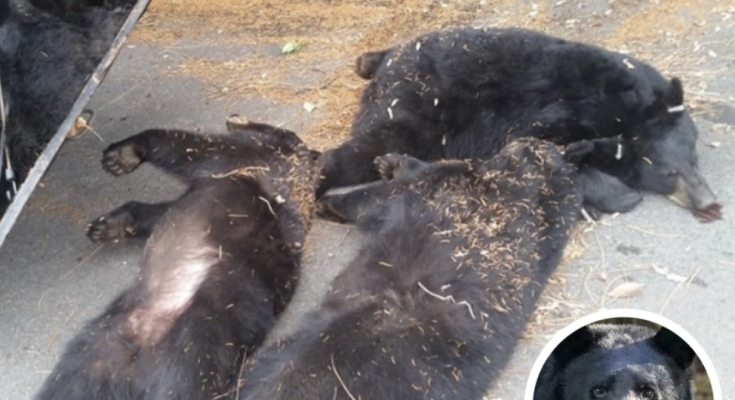Officials Reveal What Happened to the Four Bears Found Dead Outside a Church
On a chilly early December morning, wildlife authorities responded to a peculiar and troubling scene: a sow and her three cubs lay lifeless in the parking lot beside St. Monica’s Church in West Wyoming Borough, Luzerne County, Pennsylvania. They were intact, with no signs of external trauma or bullet wounds, and appeared healthy—at least at first glance. The cause of death puzzled officials and stirred concern among locals. What happened to these bears?
A Scene of Mystery
When game commission personnel arrived, the scene presented more questions than answers. The four bears were found close together near a tree, yet none exhibited obvious signs of injury. Adding to the mystery, the adult female—presumed to be the mother—had apparently died while climbing that tree. Broken branches indicated an abrupt collapse. Ordinarily, even sedated bears will try to cling to branches if they fall—so why had she fallen without a fight?
As investigators pieced together the scene, villagers speculated foul play. A reward even surfaced, offered in hopes of uncovering a potential poisoning by malicious actors. But game officials were cautious—not ready to conclude criminal action without evidence.
The Clue that Solved It All
Toxicology results delivered the answer with chilling clarity. The bears died after ingesting parts of the English yew plant—commonly used as an ornamental shrub. English yew contains taxine alkaloids, potent toxins found in the leaves and especially in the seeds and berries. These toxins can cause rapid, fatal effects.
Laboratory testing revealed that both the sow and at least one of her cubs had yew fragments—leaves and seeds—in their stomachs. Game officials noted fresh signs of foraging on a nearby yew hedge. The most likely scenario? The bears, preparing for winter, were fattening up and stumbled upon this easily accessible food source—unaware of its lethality.
Why There Were No Previous Cases
It was unexpected. For over a decade, state wildlife veterinarians and researchers had not encountered a similar case. English yew is widespread in urban areas; yet this tragic event was unprecedented, prompting wildlife experts to ask: why now?
One explanation: black bears, especially when preparing for winter, may feast on anything conveniently available—bird feeders, trash, or, in this case, ornamental shrubs. Bears chew through yew seeds, cracking their protective coats and accessing the toxic core—unlike birds, which swallow the fleshy parts whole and pass intact seeds with little harm.
A Rare Tragedy, A Broader Insight
While exceptional, the incident illuminates several broader truths:
-
Urban Wildlife Risks
As human development encroaches into habitats, wildlife encounters urban flora not designed to be food. Ornamental plants like yew, though harmless to humans, can be deadly to foraging animals. -
Vulnerability of Wildlife
Black bears, in survival mode for winter, may consume dangerous substances. The fact that the sow fell abruptly from a tree underscores how swiftly the toxin took effect. -
Public Concern and Wildlife Management
Initial fears of malicious poisoning reflect how deeply communities care about wildlife welfare. Officials had to carefully navigate speculation while maintaining scientific rigor in investigating. -
Botanical Hazards
Common garden plants may carry hidden perils. English yew, while prized for hedging and decor, is highly toxic if ingested by large mammals.
Summing It All Up
-
Location & Discovery: Sow and three cubs found dead near St. Monica’s Church in early December. No external trauma. Sow died while climbing a tree.
-
Investigation: Game officials ruled out external injury or human interference. Scenes of broken branches suggested an abrupt death.
-
Cause of Death: Toxicology revealed yew ingestion—leaves and seeds contained taxine alkaloids. Investigators found evidence of bear foraging on nearby yew shrubs.
-
Unusual Case: No similar black bear poisoning cases documented previously. Experts were surprised
-
Mechanism: Bears chew yew berries and crack seeds—releasing toxins. Birds don’t chew and thus aren’t harmed.
Final Reflection
This case of the four bears tragically taken by seemingly innocent garden hedges offers a sobering reminder of the fragile balance between wildlife and human-altered environments. Even seemingly benign flora like English yew can carry lethal consequences when ingested by animals. Wildlife officials hope this serves as a catalyst for public awareness and safer landscaping choices—especially in areas near known wildlife movement corridors.


